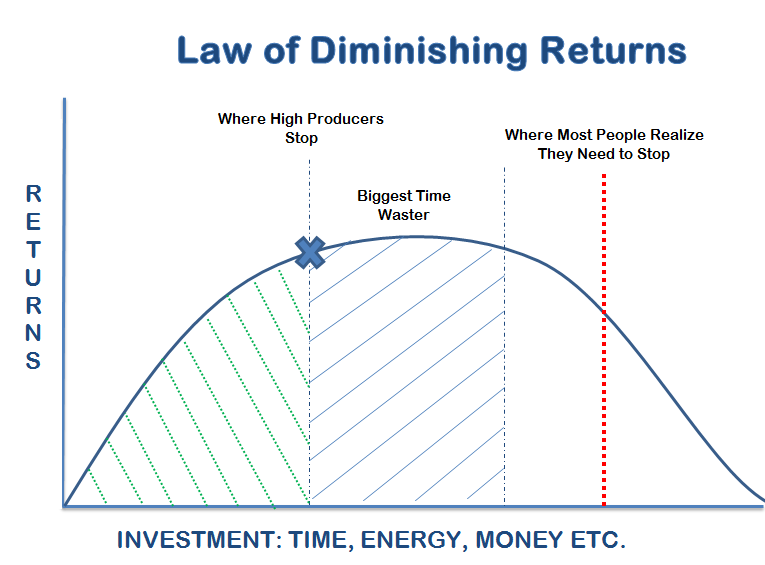GMAT Study Plan #4: Obsession Mode
Some people begin studying for the GMAT knowing full well that they are going to study for months and that they are going to prepare extensively by using all the resources that they can put together. This GMAT plan, which we call obsession mode, is for this kind of person. Studying for the GMAT in Obsession Mode is not the only way to get a high score that you need, and it isn’t a guarantee that you will get a high score. Obsession Mode is not optimal for everyone.
Obsession is not for everyone – it is extreme. In discussing Obsession Mode, let’s start with the question, can you practice too much for the GMAT?
How Much Practice is Too Much?

GMAT prep, like most activities, is subject to the law of diminishing returns
Here are the views of various parties:
- Official GMAC psychometricians (i.e., the makers of the test) do not believe that obsessive preparation is particularly beneficial. Their studied view is that a modest amount of preparation for the GMAT brings you to a natural plateau, a peak performance that is not easily improved upon. The GMAC folks have stated this view personally to me, consistently, over the years.
- Test prep companies take a somewhat opposite view that no amount of GMAT preparation could possibly be “too much.” This view has less grounding, not to mention an obvious self-interest, but the test-maker’s position does, as well (since, if scores on the test did/do yield to extensive practice, it’s slightly or greatly flawed as an aptitude test). Without getting overly spirited in the discussion, we can gather that people hit a plateau, and it’s not obvious how fast that plateau will be reached or how difficult it will be to improve upon that plateau.
- Admissions officers and admissions consultants are very different groups (since some admissions officers disapprove of admissions consulting), but they tend to have a similar view on this question: you most certainly can “over-study” for the GMAT, because you also have to nail your school research, recommendations, essays, and so on. You need to do your best on the GMAT, but you also need to get it out of the way in a timely fashion to craft applications.
Finally, pulling together, here’s my view…
Putting It Together
If you’re considering Obsession Mode, consider these factors:
- I’ve seen Obsession Mode work very well for some people (score increases of 150+ points) and barely at all for others (score increases of 0 points).
- GMAT scores tend to correlate with the amount of time that you prepare for the test. If you have the time and willpower to commit to this plan, you will likely earn a score that is closer to your optimum score. You may hit a plateau and not exceed it, but there is little risk to getting “obsessed” with the GMAT…
- … as long as you are balanced in your approach to your application as a whole. Your application essays are important and are not so simple as they might seem. Ditto for school research.
Another consideration is that you don’t want to drag out your study just because you’re willing to study long and hard. So, is Obsession Mode right for you?
Who Does “Obsession Mode”?
The biggest hazard of the obsession mode study plan is a lack of discipline. People may confuse this plan with a haphazard approach. You don’t want simply to collect a large volume of resources and plow through them. Without good planning, you may end up putting in a lot of time, buying a lot of books, and doing a lot of questions but still not improve as much as someone who commits to a different plan. You could say that, as the most ambitious study plan, the obsession mode is the one for which good planning is most important.
In obsession mode, you will study as much as possible. You will study for at least a month, and maybe up to 8 or even 12 months. For this reason, you’re going to need a lot of practice resources. Although not all practice resources are equally beneficial, you’re going to need to dip down from the very best practice resources in order to have enough material to use.
Most people who choose this plan probably have an unshakable idea that you need to do lots and lots of practice tests. In other words, you probably won’t follow my advice to take only 2 practice tests. I can live with that and I will give you the corresponding advice to do many more practice tests. However, you must make sure not to take the scores from other practice tests as seriously, because the scoring on other practice tests is not going to be accurate.
The System: n Hours Per Day, 6 Days per Week

The official materials (3 books + pack 1) should be your first source of additional practice questions and practice tests.
This study plan has the same milestones and the same basic system as The Fitness Plan. The primary adjustment is that your daily volume of practice is higher – maybe it’s two hours per day, or three hours per day.
A warning: you might nod your head to “2-3 hours per day,” but end up practicing only three or four days a week. Depending on the particulars, you might be putting in about the same amount of time as the 6-day-a-week Fitness Plan. If fewer days each week is better for your schedule, so be it… but the consistency of the Fitness Plan works better for more people.
If you’re really going full blast, the question is how to use the extra practice time productively. You should make the following adjustments to the Fitness Plan for Obsession Mode:
- You’ll need more practice questions than are in this course. You can go through the course first, but then add these resources:
- GMAT Prep Exam Pack 1 – Additional official practice tests
- The Official Guides (three books) – perfectly realistic questions, somewhat lacking explanations
- Kaplan Premier – thorough explanations, questions that are somewhat hit-and-miss on realism. The books other than Premier tend to be redundant with Premier.
- Manhattan GMAT books – slightly better than Kaplan at the difficult end of the scale, although still sometimes imperfect on realism
- Continue to mix Q and V practice.
- Continue to incorporate cumulative review into your regular practice.
- Continue not to be obsessed with practice tests, and to disregard the scores of non-official practice tests.
Revised Milestones: How Long to Study
 If you’re still reading about GMAT Obsession Mode, you probably have an ambitious score goal for your GMAT. You want to apply that same sort of thinking to your timetable. You need to have a target timetable, even if you’re willing to make adjustments to that timetable as needed. You are still playing to win, not to play.
If you’re still reading about GMAT Obsession Mode, you probably have an ambitious score goal for your GMAT. You want to apply that same sort of thinking to your timetable. You need to have a target timetable, even if you’re willing to make adjustments to that timetable as needed. You are still playing to win, not to play.
With that in mind, here are milestones revised for Obsession Mode:
- Milestone #1 is familiarizing yourself with the exam.
- Milestone #2 is taking the first GMATPrep practice test.
- Milestone #3 is reaching 100 hours of practice.
- Milestone #4 is taking the second GMATPrep practice test (this actually happens before you hit 100 hours, but it’s toward the end)
These are all the same as in the Fitness Plan. The differences are that a) you have reached these milestones faster, since you are putting in hours faster, and b) maybe you haven’t scheduled your GMAT date yet, because you’re waiting to see your second practice test score.
After you reach Milestone #4, what happens? If your second practice test is at or above your target GMAT score, you should go take the GMAT!
And if you haven’t taken the GMAT yet, you might want to go take it anyway, especially if your second practice test is within 30 points of your goal. You don’t want to take the GMAT too many times, but 2 times is quite common.
If you continue to practice:
- Milestone #5: put in 50 more hours of practice (using the materials considered above), bringing your total to 150 hours. Also, consider working with a tutor.
- Milestone #6: take a third official practice test (using the prep pack)
At this point, again consider going to take the GMAT. If you haven’t taken the GMAT yet, go take it.
If you continue:
- Milestone #7:
- Put in 50 more hours of practice using the materials considered above, bringing your total to 200 hours.
- Work with a tutor for at least 15 hours.
- Milestone #8: take a fourth official practice test (using the prep pack)
- Milestone #9: take the GMAT. You. Are. Done.
Getting Started
Getting started with the Obsession Mode plan is no more complicated than getting started with the Fitness Mode plan. To begin, get a personal study plan with a target test date 60-120 days in the future. This will bring you up to Milestone #4.